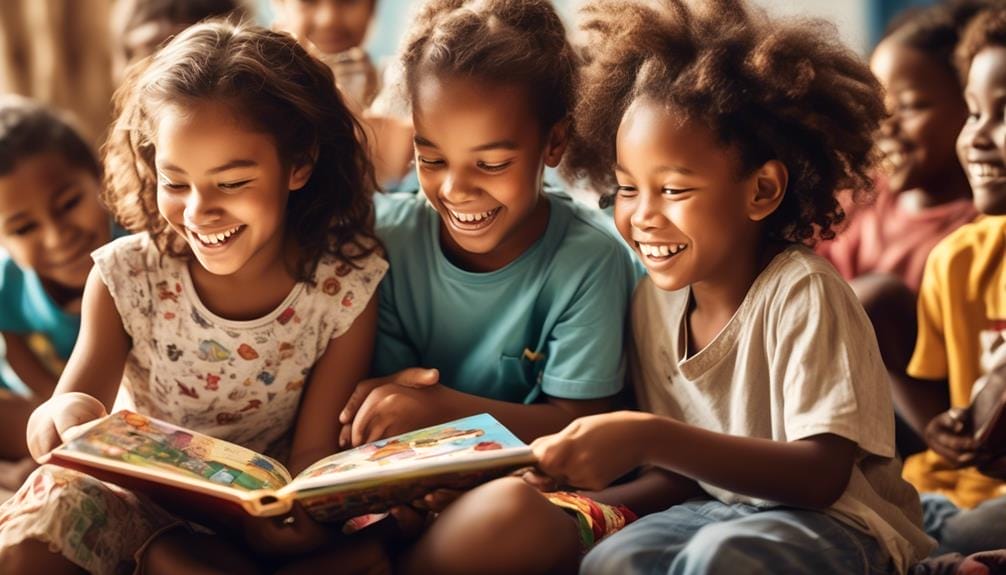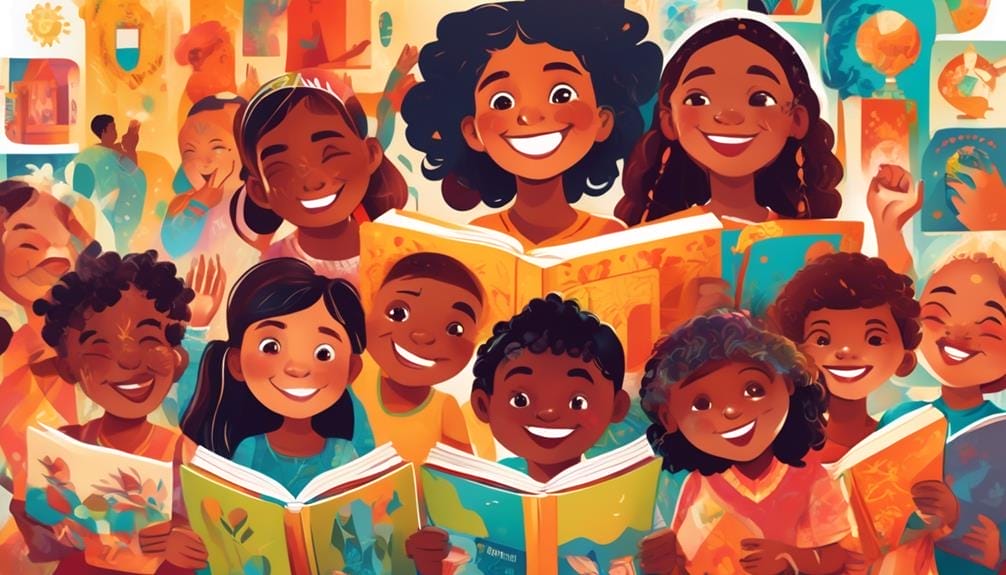When it comes to cultural diversity in kids' books, you'll find that it's not just about introducing children to different cultures, but about fostering a deep understanding and appreciation for them.
The power of representation in literature cannot be underestimated. It allows children to develop empathy, see themselves reflected in the stories they read, and gain a broader perspective of the world.
But there's more to it than that. In this discussion, we'll explore the significance of cultural diversity in kids' books, the positive impact it can have on children's lives, and why it's crucial for creating a more inclusive society.
So, let's delve into this important topic together and uncover the wonders that lie within the pages of diverse children's books.
Key Takeaways
- Cultural diversity in children's literature promotes empathy and inclusivity.
- Exposure to diverse literature enhances cognitive development and expands worldview.
- Diverse books cultivate empathy, understanding, and acceptance in children.
- Representation in children's books validates children's existence and fosters a sense of belonging.
The Importance of Cultural Diversity
Understanding the importance of cultural diversity in children's literature is essential for fostering empathy, enhancing cognitive development, and promoting inclusivity. Picture books that showcase diverse cultures provide young American readers with the opportunity to explore different shades of the world. These Children's Books play a crucial role in shaping their understanding of the global community and promoting acceptance and appreciation for all.
For example, the New York Times bestseller, 'Just Ask!: Be Different, Be Brave, Be You,' written by Supreme Court Justice Sonia Sotomayor, celebrates the diversity of children's experiences and encourages readers to embrace their uniqueness. This picture book features a group of children from different backgrounds who learn about each other's differences and similarities. By teaching young readers about diverse traditions, languages, and family structures, 'Just Ask!' fosters a sense of inclusivity and respect for others.
Furthermore, popular television shows like Sesame Street also recognize the significance of cultural diversity in children's literature. They use their platform to teach young viewers about various cultures, languages, and traditions. Through engaging stories and characters, Sesame Street promotes empathy, understanding, and acceptance.
Developing Empathy Through Literature
When it comes to developing empathy, literature has a remarkable impact on children's worldview.
By introducing diverse books into their reading repertoire, children are given the opportunity to step into the shoes of characters from different cultures and backgrounds.
This exposure fosters understanding and acceptance, allowing young readers to develop a sense of empathy and appreciation for the diverse world around them.
Benefits of Diverse Books
Diverse books have the remarkable ability to cultivate empathy through literature, providing readers with an authentic and inclusive experience that fosters understanding and appreciation of different cultures.
Here are some of the benefits that diverse books offer:
- Exposure to diverse literature enhances cognitive development, allowing children to explore new perspectives and expand their worldview.
- Reading diverse books reflects the real world, promoting inclusivity and representation, and helping children understand that everyone's story matters.
- Diverse books teach children about social justice and the importance of celebrating diversity, empowering them to be agents of change in their communities.
- True stories in diverse books inspire children with all sorts of backgrounds to embrace their own identity and find strength in their cultural heritage.
Impact on Children's Worldview
As you immerse yourself in diverse books, you open a window to a world of empathy and understanding, shaping your worldview and fostering a deep appreciation for different cultures. Through these books, you learn about the rich tapestry of humanity, where people of different backgrounds, traditions, and languages coexist.
For example, picture books like 'Just Ask!: Be Different, Be Brave, Be You' by Supreme Court Justice Sonia Sotomayor celebrate the different abilities and perspectives of individuals. Sotomayor, one of the first African-American and Latinx Supreme Court Justices, uses her own experiences to show young readers the importance of embracing diversity.
Fostering Understanding and Acceptance
To foster understanding and acceptance, immerse yourself in diverse books that open your mind to new perspectives and cultivate empathy. Here are some examples of how literature can help foster understanding and acceptance:
- Enable JavaScript in your browser to explore the story of 'Bold Women in Black' by Supreme Court Justice Sonia Sotomayor. In this book, Justice Sotomayor writes about children with different abilities who've special powers. Through the young girl's journey, adults and children alike learn the importance of working together to build a more inclusive society.
- Sotomayor celebrates the different strengths and talents of all children, regardless of their abilities. By reading about these diverse characters, we can learn to appreciate and accept people with different abilities, fostering empathy and understanding.
Promoting Inclusivity and Understanding
You know that representation is crucial in children's books.
When children see characters that reflect their own experiences and identities, it validates their existence and fosters a sense of belonging.
By building empathy through diverse stories, children can develop an understanding and appreciation for different cultures, languages, and family structures.
These books also challenge stereotypes, promoting inclusivity and teaching children to embrace the uniqueness of every individual.
Importance of Representation
Representation in picture books plays a crucial role in fostering inclusivity, understanding, and empathy by showcasing the diverse cultures and traditions of our world.
It's through these books that children are introduced to the stories, experiences, and contributions of individuals from different backgrounds. Supreme Court Justice Sonia Sotomayor, Martin Luther King, abolitionist Sojourner Truth, and poet Maya Angelou are just a few examples of the thousands of African American figures whose stories are celebrated in picture books.
These books not only teach children about Black History and civil rights, but also inspire them to become agents of change. By featuring women who changed the course of history, such as Justice Sonia Sotomayor, picture books empower young readers and encourage them to embrace diversity and work towards a more inclusive world.
Building Empathy Through Stories
Fostering inclusivity and understanding, stories have the power to build empathy and promote cultural awareness. When little ones read a book that features a young character different from them, like a little girl or the story of a slave, they can step into someone else's shoes and see the world from a new perspective.
Through these stories, children learn that we're all unique, and that our differences should be celebrated. They discover that despite our different backgrounds, we all share common emotions and desires. Multicultural stories also teach the importance of collaboration and building a community garden, showing how we can come together to make a positive impact.
Challenging Stereotypes in Literature
Stepping beyond the boundaries of traditional storytelling, literature has the power to challenge stereotypes and promote inclusivity and understanding. It allows us to explore different perspectives and experiences, breaking down barriers and fostering empathy.
When it comes to children's books, challenging stereotypes is crucial in shaping their perceptions of the world. One such book, 'The Colors of the Rainbow,' tells the story of a young boy named Max on his first day of school. Max is blind, and the book takes us on a journey as he navigates the world around him. Through vivid descriptions and evocative language, the author paints a picture of Max's daily life, showing that even though he can't see, he still experiences joy, friendship, and adventure.
This dramatic story looks at what makes Max special, highlighting the strengths and achievements of individuals with disabilities. By presenting diverse characters and celebrating their unique qualities, literature teaches kids that everyone deserves respect and acceptance.
Broadening Children's Perspectives
To expand children's horizons and foster a deeper understanding of the world around them, delving into diverse picture books is an engaging and enriching journey. These books have the power to broaden children's perspectives by introducing them to different cultures, traditions, and experiences. Let's take a look at how diverse picture books can help children see the world through new eyes.
| Authors | Titles | Themes |
|---|---|---|
| Jacqueline Woodson | "Brown Girl Dreaming" | African American experience |
| Supreme Court Justice Sonia Sotomayor | "Just Ask!" | Inclusion and understanding disabilities |
| Matt de la Peña | "Last Stop on Market Street" | Urban life and empathy |
| New York Times | "I, Too, Am America" | Civil rights and equality |
| National Portrait Gallery | "Little Leaders: Bold Women in Black History" | Female empowerment and leadership |
| Grace Byers | "I Am Enough" | Self-acceptance and inner strength |
Fostering Appreciation for Global Society

Expanding children's perspectives through diverse picture books opens their eyes to a global society, fostering appreciation for different cultures, traditions, and experiences. By immersing children in stories that celebrate diversity, they develop a deeper understanding and empathy for people from all walks of life.
Here are four ways in which diverse picture books can foster appreciation for a global society:
- Representation: Books like 'The Name Jar' and 'New Kid' feature protagonists from different cultural backgrounds, allowing children to see themselves reflected in the stories. This representation helps them develop a sense of belonging and acceptance.
- Challenging Stereotypes: 'Little Leaders' showcases the achievements of women and people of color throughout history, challenging stereotypes and misconceptions. These stories inspire children to question biases and embrace the diversity around them.
- Celebrating Differences: Books that celebrate the different abilities of individuals, such as 'Open Arms,' teach children to appreciate and respect the unique qualities that each person brings to the table.
- Cultural Exploration: Picture books with colorful illustrations and stories set in Middle Eastern countries or featuring pen pals from different cultures encourage children to explore new traditions and customs. This exploration fosters a curiosity and appreciation for the richness of our global society.
Through these diverse picture books, children can embrace the beauty of cultural diversity, fostering appreciation for a global society that values inclusivity, representation, and acceptance.
Books Reflecting Different Cultures
Books reflecting different cultures offer a window into diverse traditions, languages, and family structures, promoting cultural understanding and empathy. These books celebrate unique holidays, festivals, and cuisines from various cultures. They also highlight the historical and cultural significance of underrepresented communities. By reading these books, children can learn about the world around them and appreciate the rich tapestry of humanity.
To emphasize the importance of cultural diversity in kids' books, let's consider the example of "Henry's Freedom," a book that tells the story of a child who was diagnosed with a disability. As Henry navigates his experience as a child with a disability, he encounters new classmates from different cultural backgrounds. Through their interactions, the book showcases the abilities kids (and people) have, regardless of their cultural or physical differences.
| Benefits of Books Reflecting Different Cultures | Examples |
|---|---|
| Promotes cultural understanding and empathy | Henry's Freedom |
| Celebrates unique holidays, festivals, and cuisines | Books about Diwali, Chinese New Year |
| Highlights historical and cultural significance | Stories about the Civil Rights Movement, Indigenous cultures |
Celebrating Ethnic and Racial Diversity

As we continue our exploration of cultural diversity in kids' books, let's now turn our attention to the important topic of celebrating ethnic and racial diversity. It's crucial to have books that reflect the diverse world we live in and celebrate the richness of different cultures and races.
Here are some reasons why celebrating ethnic and racial diversity in kids' books is so important:
- Promoting empathy and understanding: Books featuring diverse characters and cultures allow children to step into the shoes of others, fostering empathy and understanding towards people from different backgrounds.
- Enhancing cognitive development: Reading diverse picture books not only exposes children to new ideas and perspectives but also enhances their cognitive development, fostering language and literacy skills.
- Celebrating unique traditions and languages: Representation of different cultures in picture books celebrates the unique traditions, languages, and family structures that make up our diverse world.
- Challenging stereotypes and promoting acceptance: Books portraying individuals with diverse abilities and disabilities challenge stereotypes and promote acceptance, teaching children that everyone deserves respect and understanding.
Exploring Books on Disabilities
Exploring the world of books on disabilities opens up a new perspective and fosters a culture of inclusion and appreciation. Picture books on disabilities are an essential part of cultural diversity in kids books, as they promote understanding and acceptance of diverse physical and mental abilities. By incorporating these books into your child's reading repertoire, you are encouraging empathy and compassion, challenging stereotypes and misconceptions, and celebrating the strengths and achievements of individuals with disabilities.
| Title | Author | Description |
|---|---|---|
| "El Deafo" | Cece Bell | This graphic novel memoir follows the author's journey as she navigates the world with a hearing impairment. It offers a relatable and empowering story for children with hearing loss. |
| "Wonder" | R.J. Palacio | A heartwarming tale about a boy with a facial difference who experiences both acceptance and bullying. This book teaches children the importance of kindness and empathy, while also highlighting the beauty of inner strength. |
| "The Deaf Musicians" | Pete Seeger | This book tells the story of a group of deaf musicians who overcome obstacles and showcase their musical talents. It encourages children to appreciate the diverse talents and abilities of individuals with disabilities. |
Exploring books on disabilities not only fosters inclusivity and representation, but also reflects the real world. By introducing your child to these stories, you are promoting a culture of acceptance and appreciation for all individuals, irrespective of their abilities. It is through these books that children can learn about and celebrate the unique experiences and contributions of individuals with disabilities.
LGBT+ Representation in Children's Books

LGBT+ representation in children's books brings visibility and validation to diverse sexual orientations and gender identities, fostering inclusivity and empathy among young readers. Including LGBT+ characters and families in kids books challenges heteronormativity and promotes acceptance and understanding of different family structures and relationships.
Here are four reasons why LGBT+ representation in children's books is important:
- Breaking Stereotypes: These books encourage self-expression, individuality, and embracing diversity. They challenge traditional gender roles and stereotypes, teaching children that there's no one 'right' way to be.
- Representation Matters: LGBT+ children and families deserve to see themselves reflected in the books they read. By featuring characters who share their experiences, these books provide a sense of belonging and affirmation.
- Building Empathy: Reading about characters with different sexual orientations and gender identities helps children develop empathy and understanding. It teaches them to appreciate and respect the differences in people they may meet in their own lives.
- Starting Conversations: LGBT+ representation in children's books opens up important conversations about love, acceptance, and diversity. It gives children a safe space to ask questions and learn about different types of families and relationships.
LGBT+ representation in children's books is crucial for creating a more inclusive society where everyone's experiences are valued and celebrated. These stories have the power to shape young minds, fostering acceptance and empathy that will last a lifetime.
Frequently Asked Questions
What Children's Book Shows Diversity?
You should check out "The Colors of Us" by Karen Katz. It's a children's book that shows diversity by celebrating different skin colors and promoting the importance of inclusivity and acceptance.
How Do Children's Books Support Cultural Diversity?
Children's books support cultural diversity by teaching empathy through diverse characters, celebrating different cultures, including diverse family structures, exploring traditions worldwide, breaking stereotypes, promoting inclusivity, addressing social justice issues, and encouraging multicultural friendships.
What Popular Children Books Deemed Not Culturally Diverse Enough?
Popular children's books have been criticized for lacking representation and reinforcing stereotypes. It's crucial to address cultural biases and explore different ethnic backgrounds, promoting understanding through diverse books. Authors play a vital role in challenging traditional narratives and creating culturally diverse literature.
What Makes a Good Multicultural Children's Book?
Representation matters in a good multicultural children's book. Authentic storytelling celebrates different traditions, introduces new perspectives, and teaches empathy. Embrace multicultural characters, explore global themes, and reflect our diverse world—encouraging inclusivity and acceptance.
Conclusion
You've embarked on a literary journey, where cultural diversity shines bright like a constellation of stars. Through the pages of children's books, you have explored the colorful tapestry of traditions, languages, and customs, fostering empathy, inclusivity, and understanding.
Your perspective has broadened, opening doors to a global society where acceptance and appreciation thrive. As you celebrate the vibrant melodies of different cultures, remember that these stories hold the power to create a more harmonious and inclusive world for all.
Keep turning the pages and let diversity be your guiding light.


